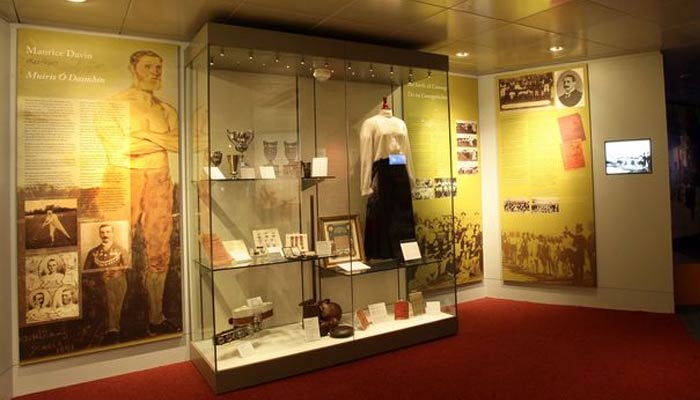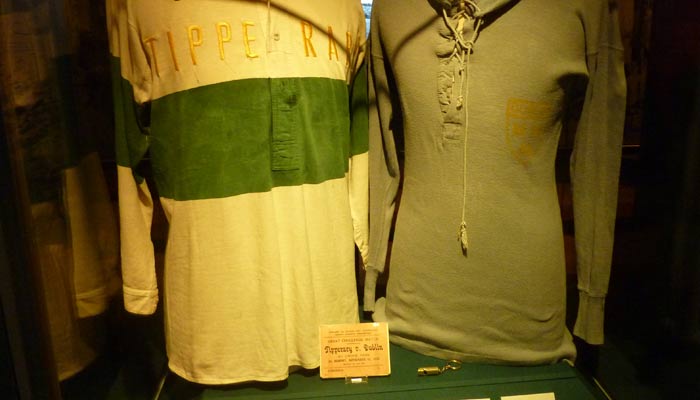- Back
12/07/2018
Duke and Duchess of Sussex visit Croke Park
We were delighted to welcome the Duke and Duchess of Sussex to Croke Park as part of #RoyalVisitIreland.
The visit began with a guided tour of our treasured GAA Museum, which brings to life the story of Gaelic games from ancient times to present day. Niamh McCoy, the GAA Museum Director presented items from the 1888 US ‘Invasion Tour’, replica Camogie uniform from 1904, Bloody Sunday artefacts and the original All-Ireland Trophies, the Sam Maguire and Liam MacCarthy Cups. Find out more about each item below.
On the pitch, the Royal couple were given a showcase of our games by legends Joe Canning, Michael Murphy, Rena Buckley, Lyndsey Davey and wheelchair Hurling All-Stars Lorcan Madden and Sarah Cregg.
Members of the Dermot Earley Youth Leadership initiative spoke about their experience of the programme while children from the four provinces brought to life the GAA’s Go-Games, Football and Hurling, and Fun & Run – a new version of Rounders adapted for persons with special needs.
Some of the artefacts presented to the Royal couple in the GAA Museum included;
US ‘Invasion Tour’, 1888
A hurl, used by Pat Davin (brother of Maurice Davin), used on the ‘Invasion Tour’ in 1888 when the GAA organised a promotional tour of America consisting of over 50 hurlers and athletes. This tour became known as the ‘Invasion Tour’ because at least 17 out of the 50 athletes participating decided to settle permanently in America.
(There is also an 1888 Invasion Tour medal – one of the earliest GAA medals and was awarded to those who played in the hurling matches organised as part of the tour).

The 1888 Hurley belonging to Pat Davin is in the foreground
Geraldines GAA Club Minute Book, 1909-1915
Michael Collins was the Secretary of the Geraldine’s GAA club, London, from 1909-1915. The minutes of the meeting on June 30th record the club protesting against the London GAA Board’s decision to seek an end to the GAA’s ban on ‘foreign sports’. The club passed a motion calling on the governing body of the GAA to ‘stand by those who wish to preserve the Gaelic spirit of the Association unimpaired’.

Minute Book from Secretary of the Geraldine’s GAA Club, Michael Collins
Replica Camogie Uniform, 1904
The game of Camogie – hurling for ladies - originated in Dublin through a branch of the Gaelic League, an Irish language organization established in 1893.
In 1904 rules for the new game of Camogie were drawn up. The rules were based on hurling, but modified to suit female players. The first competitive match was played on 17th July 1904.

Replica Camogie jersey from the early 20th century
Bloody Sunday, 21st November 1920
In 1920, the Irish War of Independence was underway. On 21
st November 1920 13 spectators and one player (Tipperary’s Michael Hogan) were killed while attending a football match in Croke Park. Earlier that day members of Michael Collins’ ‘Squad’ had assassinated 14 British spies. The British Auxiliary Forces believed members of Collins’ gang may have been attending the game in Croke Park and, about 15 minutes into the game, invaded the grounds and opened fire on spectators.
Of the 14 killed in Croke Park on that day, there were three children and a young woman, Jane Boyle, who had attended the game with her fiancé who she was due to marry the following week.
In all, 28 people were killed in Dublin on 21
st November 1920, on what is known as Bloody Sunday.

Dublin and Tipperary jerseys and original match ticket from Bloody Sunday, 1920
Original All-Ireland Trophies
Sam Maguire Cup
Named after a Cork man who was influential in GAA circles in London in the early 20
th Century, the Sam Maguire Cup is the most iconic trophy in Irish sport – the Holy Grail for every footballer. The trophy was first played for in 1928 and won by Kildare. The original trophy resides permanently in the GAA Museum after being retired in 1987. The current trophy is an exact replica of the original. The Sam Maguire cup is based on the Ardagh chalice from the 8
th century, which is an iconic and treasured artefact in the National Museum of Ireland.
Liam MacCarthy Cup
Awarded to the winners of the All-Ireland hurling championship and, like Sam, named after a man with Cork connections who was hugely influential in London GAA. The design of the Liam MacCarthy Cup is based on that of a medieval drinking cup. First presented in 1923, the cup was in use until its retirement in 1991 when it was replaced with an exact replica.
Find out more about the GAA Museum & Tours at
crokepark.ie/gaa-museum-tours
Coverage:
Independent.ie
IrishTimes.com
Buzz.ie
IrishExaminer.com
RTE.ie
- Back